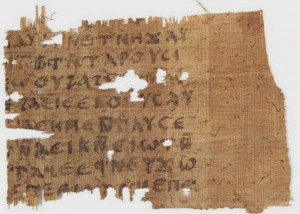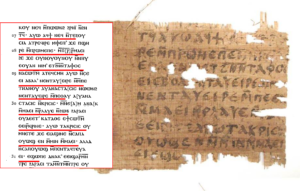“Jesus Wife” Papyrus Under Attack: Again

I’ve never met Professor King but she seems to be a fighter. In the face of criticism, she disappeared for about two years but she reappeared a few weeks ago armed with cutting edge science. The papyrus on which the controversial statement was written passed Carbon-14 tests, demonstrating that it could be as early as the 7th century and the ink was, without question, ancient. There are more tests results and more stats but the bottom line is that the papyrus is genuine. Harvard Theological Review, which had spiked her original article now published it and the Smithsonian Channel aired the previously cancelled documentary. Once again, the Jesus Wife papyrus made headlines around the world.
But the naysayers never sleep. They’ve come back with a vengeance. Unable to criticize the Jesus Wife papyrus, they have now attacked another papyrus – a fragment of the Gospel of John. Since this fragment was part of the same collection as the Jesus Wife papyrus, they figured that if they can invalidate the Gospel of John papyrus, the Jesus Wife papyrus could be discredited by association. So far, they’ve succeeded. King has gone silent again and the naysayers have declared the Gospel of John “a modern forgery”. And what do they base this on? Well, if you can cut through the reams of pseudo-science, graphs and Coptic quotes, what they’re saying is as follows:

First, the Gospel of John fragment uses a dialect of Coptic that was no longer used by the 6th century, and the Jesus Wife papyrus is dated, at the earliest, to the 7th century. Good grief! Can you really be sure that no one was still using the dialect in the 7th century? Aramaic hasn’t been used for thousands of years in the Middle East but there are still villages in Israel and in Syria, for example, that speak Aramaic today. The second big “smoking gun” for the naysayers is that the Jesus Wife papyrus and the Gospel of John papyrus are written by the same hand, use exactly the same ink and exactly the same writing instrument. One more time, good grief! First of all, I haven’t seen one naysayer interviewed who is an expert on ancient ink or writing instruments. But even if this were true, why couldn’t both fragments have been written in the 7th century? If they are similar, why does this prove forgery? Their third piece of “evidence” is that there is a hole in the fragment and that on one side of the hole the line is written straight into the hole, and on the other side the writer seems to have written around it. For the third time, good grief! Can you really analyze smudges around the hole with such precision? And why would a modern forger be stupid enough to write straight into the hole on one side, and around the hole on the other? Besides, to my untrained eye, if I look at the picture at the head of this blog, it looks like the hole cuts into the writing, and not the other way around. Meaning, the writing came first. Their final piece of “shocking evidence” for forgery is that the Gospel of John fragment perfectly matches another ancient Coptic manuscript that went online 10 years ago. This proves, they say, that the modern forger copied the fragment from the internet. But why would similar line breaks imply forgery? Don’t ancient Torah texts have similar line breaks? In any event, the fact is that the two texts don’t match each other perfectly. Even the naysayers admit that there is at least one difference in the line breaks and that there is a “deviation” in the dialects used. As for the ink, they admit that there is a slight difference between the various inks. They don’t match but are “highly similar”, they say. Why wouldn’t they be? Why wouldn’t ancient texts and inks be “similar” to each other? Why does any of this prove forgery?
I want readers to follow closely what is being said here. What the naysayers are arguing is that a genius of a modern forger used an ancient piece of papyrus and got hold of ancient ink to create a modern forgery that has fooled at least half a dozen of the world’s top scholars, but the same genius was a complete dolt when it came to content. He decided to copy the content off the internet and, faced with a little hole in the papyrus, he couldn’t make up his mind to write around it or into it. Does this make any sense? Obviously not. But if you throw some Coptic words, like “Lycopolitan”, into the discussion, you can make a CNN’s newsman’s head spin and he’ll say anything you want.
The other intriguing thing about all these claims of forgery is that no one has ever come up with a living, breathing forger. No one has ever pointed to a single deal going down. No one has shown any evidence whatsoever that anyone has ever profited from these Jesus related so called “forgeries”. What’s the motive? And who is selling these fragments, to whom and for what price? If someone actually wanted to forge Jesus related paraphernalia, why would they forge controversial Coptic fragments that throw theologians into a tizzy? They would be much better off forging stuff that the Vatican and the protectors of Pauline theology agree with. Then there would be a market for it and nobody would be screaming “forgery”. The bottom line is that there is no forger. Egyptologist Gerhard Fecht at the Free University in Berlin authenticated the Jesus fragment at least two decades before it was supposedly forged. And by what slight of hand is an attack on the Gospel of John papyrus proof that the Jesus Wife papyrus – that has passed every single scientific test – a forgery?
All this “forgery” hysteria is clearly nonsense, but it’s effective nonsense. I hope Professor King and her colleagues come out punching and opposing pseudo-science with more real science. This time on the Gospel of John papyrus. But as with Professor Morton Smith, the damage is done. The Jesus Wife papyrus is now “controversial” and “tainted”. Tomorrow, the naysayers will go after Gerhard Fecht’s letter. I’m sure they’ll argue that that’s a forgery too. And if they can’t, they’ll go after a colleague of Fecht’s and argue guilt by association. For my part, I have to believe that at the end of the day the sheer weight of evidence will defeat the Coptic smoke blowing theologians. After all, how many times can you cry “wolf”? And how many times can you cry “forgery”?
Check out my latest blog in the Times of Israel: David Stoliar, Lone Survivor of “Jewish Titanic”, Dies at 91

